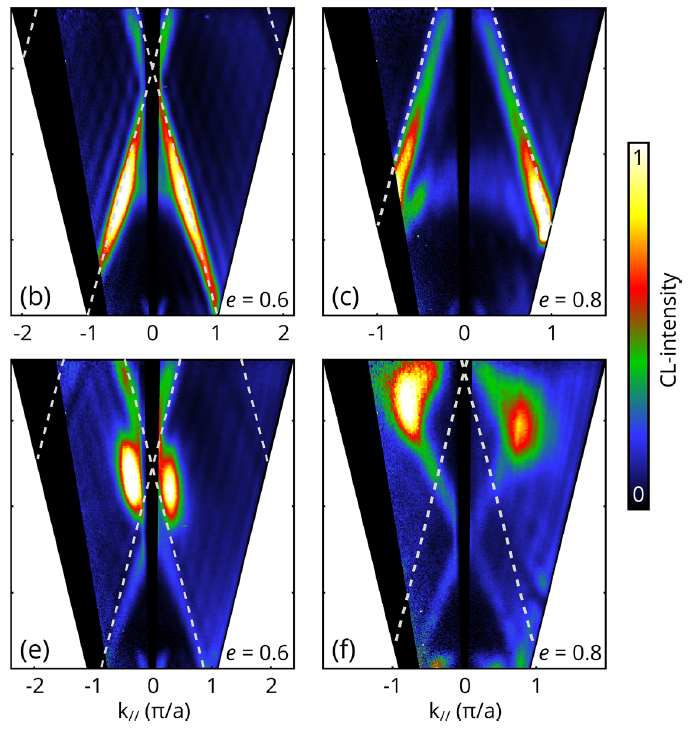The SPARC cathodoluminescence detector has 6 imaging modes which can enhance your research and provide you with an important information about your samples. Keep reading if you would like to know what exactly the SPARC can benefit your research!
Rapid inspection and region-of-interest finding
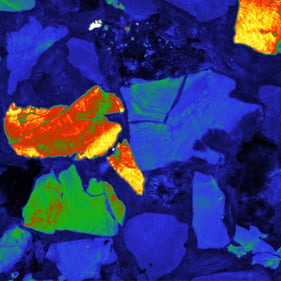 By means of a photomultiplier tube (PMT), the SPARC CL detector can inspect large areas of the sample easily and rapidly, also enabling efficient region-of-interest finding. This can be done by using the Fast-intensity mapping mode in the SPARC system that records the cathodoluminescence intensity for every beam position with a single-pixel light detector. A filter wheel can be used for spectral differentiation. Some applications are: mapping defects, measuring radiation efficiency, and recording color changes in a large variety of (doped) dielectric, ceramic, semiconductor and geological materials.
By means of a photomultiplier tube (PMT), the SPARC CL detector can inspect large areas of the sample easily and rapidly, also enabling efficient region-of-interest finding. This can be done by using the Fast-intensity mapping mode in the SPARC system that records the cathodoluminescence intensity for every beam position with a single-pixel light detector. A filter wheel can be used for spectral differentiation. Some applications are: mapping defects, measuring radiation efficiency, and recording color changes in a large variety of (doped) dielectric, ceramic, semiconductor and geological materials.
Insight into the band structure of periodic systems
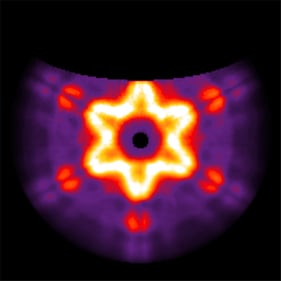 The direction in which light is emitted often contains valuable information on how a (nanostructured) object scatters and emits light, and thus helps to understand the band structure of periodic systems. The SPARC system has an Angle-resolved CL spectroscopy mode, which uses a high NA parabolic mirror to collect the emitted light and retrieve the emitted intensity as a function of the emission angle by projecting an image of the mirror onto an imaging camera.
The direction in which light is emitted often contains valuable information on how a (nanostructured) object scatters and emits light, and thus helps to understand the band structure of periodic systems. The SPARC system has an Angle-resolved CL spectroscopy mode, which uses a high NA parabolic mirror to collect the emitted light and retrieve the emitted intensity as a function of the emission angle by projecting an image of the mirror onto an imaging camera.
Wavelength measurements: look into optical and structural properties of materials
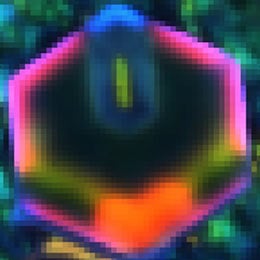 The wavelength distribution (spectrum) of the emitted light often contains valuable information on the local optical and structural properties of the material. In the hyperspectral imaging mode of the SPARC, a complete spectrum is collected from every pixel, providing a high-resolution spectrum in one shot, for every electron beam position. By scanning the e-beam across the sample, a spatially resolved hyperspectral image is produced. A variety of imaging detectors can be used to cover a spectral range of 200-1600 nm.
The wavelength distribution (spectrum) of the emitted light often contains valuable information on the local optical and structural properties of the material. In the hyperspectral imaging mode of the SPARC, a complete spectrum is collected from every pixel, providing a high-resolution spectrum in one shot, for every electron beam position. By scanning the e-beam across the sample, a spatially resolved hyperspectral image is produced. A variety of imaging detectors can be used to cover a spectral range of 200-1600 nm.
Polarization measurement: study coherence, scattering, birefringence, and chirality
 Polarization plays a key role in light-matter interactions. Besides color (energy) and momentum (propagation direction), light is also characterized by a polarization, which describes in what direction the electro-magnetic fields in the light oscillate. Using a polarizer or even a full polarimeter in the angle-resolved mode of SPARC allows for the reconstruction of the polarization state (Stokes vector) of CL for different emission angles. The CL polarimetry results obtained from the SPARC can be used to study coherence, scattering, birefringence, and chirality. Additionally, it can be used to block spurious background radiation and correct for aberrating effects in the collection optics.
Polarization plays a key role in light-matter interactions. Besides color (energy) and momentum (propagation direction), light is also characterized by a polarization, which describes in what direction the electro-magnetic fields in the light oscillate. Using a polarizer or even a full polarimeter in the angle-resolved mode of SPARC allows for the reconstruction of the polarization state (Stokes vector) of CL for different emission angles. The CL polarimetry results obtained from the SPARC can be used to study coherence, scattering, birefringence, and chirality. Additionally, it can be used to block spurious background radiation and correct for aberrating effects in the collection optics.
Understand material properties and physical processes in materials
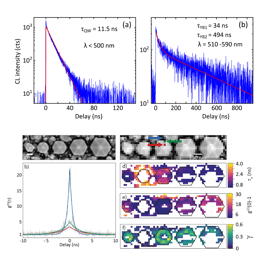 Studying the time dynamics of materials can be vital for a better understanding of physical processes and material properties. Time-resolved CL imaging using the Lab Cube together with the SPARC, provides insights into the time dynamics of materials by performing lifetime imaging, i.e., measuring the exponential probability distribution for light emission as a function of time delay. Alternatively, the 2nd order autocorrelation function can be measured, to perform g(2) imaging. Time-resolved imaging is highly relevant for a wide range of applications, including semiconductors for photovoltaics and light-emitting devices, as well as single emitters for quantum information processing and sensing.
Studying the time dynamics of materials can be vital for a better understanding of physical processes and material properties. Time-resolved CL imaging using the Lab Cube together with the SPARC, provides insights into the time dynamics of materials by performing lifetime imaging, i.e., measuring the exponential probability distribution for light emission as a function of time delay. Alternatively, the 2nd order autocorrelation function can be measured, to perform g(2) imaging. Time-resolved imaging is highly relevant for a wide range of applications, including semiconductors for photovoltaics and light-emitting devices, as well as single emitters for quantum information processing and sensing.
Map the optical properties of dispersive and anisotropic systems
 Energy-Momentum Cathodoluminescence Imaging using the SPARC is a new technique which can be applied to track the directionality of the emitted light through energy- and momentum-space with very high precision. It is a great tool for mapping the optical properties of a wide range of dispersive and anisotropic systems, paving the way for a broad range of studies on complex nanophotonic systems.
Energy-Momentum Cathodoluminescence Imaging using the SPARC is a new technique which can be applied to track the directionality of the emitted light through energy- and momentum-space with very high precision. It is a great tool for mapping the optical properties of a wide range of dispersive and anisotropic systems, paving the way for a broad range of studies on complex nanophotonic systems.
Would you like to know more about CL? Make sure to sign up for our ongoing CL webinar series, Cathodoluminescence Fundamentals
.png)



